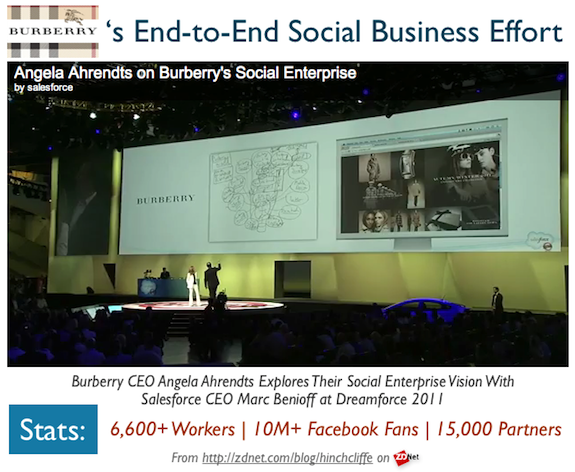Social business success: Burberry

We're now almost a third of the way through this a ten part series -- please read the overview here -- that takes a detailed look at current real-world examples of social business in large enterprises. In the last post, we explored what construction supplies giant CEMEX has accomplished with Enterprise 2.0 in a surprisingly short period of time. In today's case study we look at luxury brand Burberry, who has developed a far-reaching vision of being the first company to be "fully digital end-to-end."
Important Note: I've had a good amount of mail about the case studies presented here so far. By far the most comments are mentioning that ROI information is often scarce in these examples. This is often because these social business efforts, though highlighted here because they are genuine successes in terms of adoption, are all relatively new. Therefore there is less long-term information on the ultimate business impact. In general, I'd point readers to the current social business performance numbers by pointing to what companies overall are currently self-reporting as widely reproducible results when they go down the social business road. For more details, I've explored the latest findings in detail in terms of both the long term lessons of sustained social business adoption as well as the latest results in terms of specific benefits of Enterprise 2.0 as applied to workforce collaboration. When we combine the examples of the more mature 2nd and 3rd wave efforts presented here along with the long-term data, I find that a rather compelling picture emerges.
Burberry's social business story was famously highlighted during last year's Dreamforce event, where their CEO Angela Ahrendts explained how they strategically partnered with Salesforce to create a true social enterprise. Founded in the mid-1800s, Burberry has had its ups and downs but is currently performing quite well as a worldwide luxury goods designer. They rang up $1.5 billion in sales last year and have over 6,600 employees working in over 200 locations, creating a geographic challenge for creating a truly global culture for which I find many companies look to social media as a potential solution.
In their social business effort, Burberry was clearly thinking big: A true digital company must use digital channels through and through for all interaction. Said Ahrendts for the customer-centric vision:
The experience would be that a customer would have total access to Burberry, across any device, anywhere. And they would get exactly the same feeling of the brand, feeling of the culture, regardless of when, where, how they were accessing the brand. Everyone now can come into Burberry World the journey and mission that Burberry is on. And for any CEO that is skeptical at all: You have to create a social enterprise today. You have to be totally connected with everyone that touches your brand. If you don't do that, I don't know what your business model is in five years.
Not withstanding the obvious kool-aid, the message for Burberry's effort was clear: The future of business is "borderless, agnostic, and it's in the new universal language: social media." Perhaps more importantly, unlike the Cemex social business story, which had to deal well with a significant percentage of older workers, in sharp contrast, over 70% of Burberry's workers are under 30, making the fast rapid embrace of social media, internally and externally, potentially much easier. What's more, instead of just Enterprise 2.0, Burberry wanted a truly integrated end-to-end vision. The full spectrum of social business in other words. Not for them was a set of social "islands": Isolated workforce collaboration, a separate Social CRM effort, and standalone social branding, marketing, and online experience. They wanted everything social in the company to be connected together seamlessly from a business and technology perspective.
Citing it as one of the fastest efforts they've ever put together and dubbed Burberry Community, the vision was to connected back-end, to front-end, to workers, to customer experience in a unified way using the various capabilities of Salesforce, from its CRM capabilities to its increasingly sophisticated Chatter social networking services.
In contrast to some of the other stories, the internal adoption numbers for Burberry's efforts are less clear (and not public), but the business result bottom line seems to be a bit clearer. Press reports are giving their social business strategy a good chunk of the the credit for a 21% jump in profits in the fourth quarter of 2011. Burberry has been extremely effective at building a social customer experience and has over 10 million Facebook fans as they've situated Chatter and other technologies such as IM for workers to engage with each other and customers to drive better results. As their CEO says: "The social enterprise has got to drive economic value." And if early results are any indication, that is starting to happen for them.
Next Story: BASF
Don’t miss a single success story. Subscribe to my blog and I’ll keep you updated with the latest case studies.
Other case studies:
- Exploring Enterprise 2.0 Success - Social Business Story #1: Alcatel-Lucent
- Social business success: CEMEX
Note: If you'd like to consider adding your organization to this list, represent a Fortune 500 or Global 2000 firm, and have publicly released your data for the first time in approximately the last 24 months, please send me your information via e-mail here.
